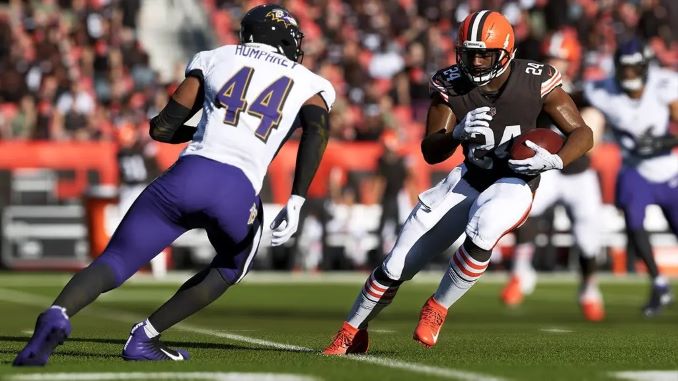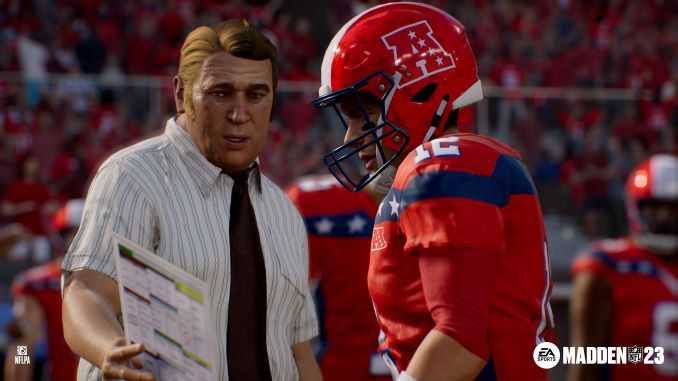Madden NFL 23 Comes Up Short Again, But It’s Still the Only American Football Game in Town
Games Reviews Madden
Iteration with diminishing creative returns is the name of the game in mass media right now, but sports videogames have long been pioneers in the field. Madden NFL 23 is another in the long line of examples showing that EA monopolizing the professional football license is to the detriment of consumers. Because it remains an effective marketing tool for the NFL and an effective tool for teaching young people the game, they are unlikely to lose this exclusive license (it was extended this year to 2026). If you haven’t played Madden in a half decade or more, it might be worth trying out to see a few new features, but, as usual, it’s difficult to endorse a massive purchase for a minor annual upgrade. It got me excited for the NFL season, and then disappointed that there are 15- and 20-year old games that deliver a comparable and sometimes superior experience.
Madden NFL 23 is a solid game of on-field football with tremendous presentation. It looks a lot like NFL game days, though the halftime show still isn’t as in-depth as the Primetime show from ESPN NFL 2K5, a game that came out 18 years ago. The new skill-based passing mechanics—which are good and optional—allow players to target receivers more precisely, putting the ball where only they can catch it. The gameplay tutorials are a great onboarding feature and teach effectively, from which pass patterns work best against which defensive coverage to utilizing run-pass option plays. The physics and animations are impressive. Strictly on the field between the sidelines, it’s a defensive game in “Simulation” mode (the game also offers “Arcade” for a more high-flying experience and the “Competitive” mode which is geared toward online play), so players will likely want to extend the minutes-per-quarter for more realistic results in franchise mode. Also, the default tuning leads to too many interceptions. It’s one thing for me to throw three picks because I’m rusty and impatient; it’s a whole other for me to throw six and catch four in a 20-minute game against the computer. Also, field goals seem too easy to miss, but there are adjustable accuracy sliders. I’m not sure yet if injuries happen too frequently or are realistically random.
The “Madden Legacy Game” that opens on start-up before the main menu landing screen is kind of cool, pitting All-Madden NFL players against each other on a team representing each conference in the Oakland Coliseum. It’s funny because of the variety of ages players are listed at (Joe Montana’s age is listed as 60, Brett Favre’s as 46, several other players at ages closer to their actual primes); it also made me want to play All-Pro Football 2K8. While this mode serves as an homage to John Madden, with two younger versions of himself coaching against each other on each sideline and a brief highlight of famous moments, the overall game doesn’t quite uphold the namesake coach-commentator’s legacy. Why not have a legendary moments mode like ESPN NFL 2K5 had and NBA 2K is going to have with the returning Jordan Challenge Mode?
Instead, there are mini-challenges to win Ultimate Team points; nothing specific to Madden’s coaching career or his teams with the Raiders, just a talented ultimate team with some Hall of Famers and current icons swapped into the colors of your favorite team, trying to pull off some minor statistical achievement for Ultimate Team points (Randy Moss’s first challenge requires 100 yards passing and two passing touchdowns in the first half; the yards and scores don’t even have to go to him). Unfortunately, as has been the case for several years now, the entire game is designed to funnel players toward “Ultimate Team,” the mode that adapts trading card mechanics to the digital space. In my time with it, I learned players can get different versions of the same athlete at different ratings or duplicate cards, but can’t use multiple in your lineup. Luckily, you can trade them back in for a pittance to go toward your next pack of player cards.
While I doubt John Madden the Tinactin spokesperson would bristle at the monetization focus of his game, it bothers me. I frequently compared Madden to a handful of games in the genre, several by this publisher, and it either comes up short or feels like an inadequate move forward. Features like momentum and player roles existed in older games before being taken out and put back. Plus, there was a time when players could sub out the curated soundtrack for NFL Films music. Those were good times.

The franchise mode’s big changes are minimal. In free agency, prospective signings have a short list of interests to let you know why your organization does or does not appeal to them (like an abbreviated version of the NCAA Football recruiting pitches). There are also coach skill trees whose points are unlocked in games and locker room interactions (also something that was in the later NCAA years that appeared recently in Madden). The press conferences are less immersive and more stop-and-start than in EA’s FIFA game. In franchise mode, Madden NFL 23’s draft scouting is barebones and perfunctory compared to, say, FIFA, where your scouts give you an in-depth look at prospective youth players and must unlock the stats of professional transfer targets, even within your own league.
Also, the franchise computers forgets how old your players are. In the second year of my franchise, my coach talked to a veteran offensive lineman about tutoring “rookie” Alex Leatherwood, who by that point in the game was going into his third year as a professional. There are also statistical anomalies like, for instance, your number one receiver catching no touchdowns through 17 simulated games while leading the team in catches and yards.
Back on the field, the no-huddle tempo works reasonably well, but position shifts don’t; for instance, if you run an empty backfield set with your runningback in the slot and audible to a formation with the running back in the backfield, depending on alignment, the running back might end up at the tight end or wide receiver position, with a tight end or wide receiver in the backfield. This has been a problem for upwards of 16 years. No one in all that time has thought it worth fixing?
Depth charts and positions are still locked to reality in a way that is unrealistic. What I mean is this: for the Las Vegas Raiders, Maxx Crosby has been a defensive end for most of his career in a four-down lineman defense. Because the game is now designed with the Raiders running a 3-4 defense, he is set as an outside linebacker. But the game doesn’t automatically dynamically switch his position if you choose to run a different defense or he becomes a free agent. Granted, the depth chart now includes positions like “Slot Receiver” and “Slot Cornerback,” so the game is smart enough to move your number-one or number-two receiver or corner into that position if that’s how the defense is set up. It’s not a problem on its own, but it stands out because making player position more fluid to reflect the NFL is something that players have been asking for since at least 2012 on the Operation Sports message boards.
At this point, the audience that Madden is targeting might be better served by a free-to-play model or an every-other-year release. Regardless of whether developers are interested in doing substantial upgrades to the franchise mode on a year-to-year basis, publishing is focused on financial extraction in Ultimate Team. It is what it is; I was naively hopeful that after several years of critics and fans haranguing over this issue, change might come to restore our collective faith. No such luck. The gameplay upgrades are too slight to charge $70-$100 every year for this game. Maybe a release every other year with DLC and roster updates in between? You can still charge for that stuff. My greatest sadness is that this product makes me anxious about what EA Sports College Football will be like. If it’s anything like the new Madden, it’ll be a decent time on the field and a slog in the dynasty mode, with everything geared toward getting players to pay for digital trading cards.
Madden NFL 23 was developed by EA Tiburon and published by EA Sports. Our review is based on the Xbox Series X|S version. It’s also available for the PlayStation 5, PlayStation 4, Xbox One, and PC.
Kevin Fox, Jr. is a freelance writer, editor, and critic. He is a former Paste intern with an MA in history, who loves videogames, film, TV, and sports, and dreams of liberation. He can be found on Twitter @kevinfoxjr.